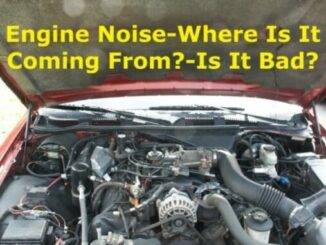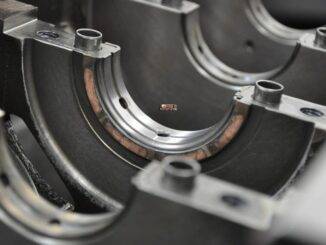
An engine bearing is a small and relatively inexpensive component, of an internal combustion engine.
However, failure of an engine bearing most often leads to, serious reconditioning work of the engine.
Most often, including its disassembly, regrinding of the crank and replacing the engine bearings. And, that’s only, if it was caught in time.
So, as long as there’s a steady flow of clean oil, an engine bearing will usually last a long time.
But, if the oil’s dirty or if the supply is cut off, that’s when the problems start. And, that’s why, bearing lubrication is so critical. Above all, from the second the engine turns over, until it is shut down. Also, identifying the root cause of a bearing failure, is crucial in preventing a repeat failure.
However, failures can also be, the result of simple installation errors.
How Engine Bearings Work
Though there is not much to an engine bearing at first glance, it is a true marvel of engineering.
All Bearings Depend On A Film Of Oil, To Keep Shafts And Bearing Surfaces Separated:
- At rest, the shaft and bearing, are always in contact.
- On startup, the shaft, contacts the bearing briefly.
- Running, the shaft pulls oil from the clearance space, into the wedge shaped area, between the shaft and bearing.
This oil wedge, lifts the shaft off the bearing surface, and supports it during engine operations. As a result, the shaft and bearing surfaces, will remain separated. But, only under normal operating conditions, and a constant supply of clean oil.
Some Of The Properties Required For Bearing Materials Include:
- Fatigue strength.
- Seizure resistance.
- Wear resistance.
- Conformability.
- Embeddability.
- Corrosion resistance.
- Cavitation resistance.
The Most Common Bearings, Used In Engines Are:
Crank Main Bearings
So, most engines have, at least two main bearings. One at each end of the crank. Main bearings, support the crank, in the engine block. A main bearing has of two parts. An upper half, and a lower half. So, the upper half of a main bearing, commonly has an oil groove, on the inner surface.
The lower half of a main bearing, has a hole for passing oil, to the feed holes in the crank. Furthermore, some main bearings may have, a built in thrust bearing. And, are used to support axial loads and prevent movements, along the crank axis.
Crank Rod Bearings
Con rod bearings, are mounted in the big end of the con rod. A bearing has two parts, (commonly interchangeable). Rod bearings, provide rotating motion of the crank pin, within the con rod.
Camshaft Bearings
Camshaft bearings, support the camshaft in the engine and allow for its rotation.
Crank Thrust Bearings (crank thrust washers)
In an engine block, crank thrust bearings, are placed into grooves formed in the, engine blocks webbing. Their purpose is to, limit the crank’s forward and backward movement. As a result, keeping the crank, within a specific area of motion.
Piston Pin Bushing (small end rod bushing)
Bushings in the small end of the rod, provide relative motion of the piston. Relatively to the con rod, joined to the piston.
So, Proper Selection Of Bearings, Will Go A Long Way, Toward A Successful Engine Rebuild.
Furthermore, it is a good idea to inspect your old bearings, before starting any new rebuild or repair. Because, they do tell a story and will help find, the original problem.
So, identifying the root cause of a bearing failure, is crucial in preventing, the recurrence of the failure. A simple replacement of the bearings, will not address the factors, that led up to the failure. It is important to note, that in many cases, the premature bearing failure, is due to a combination of causes. One common cause, is the wrong bearing clearance. So, if you do not find the original cause, bearing failure can repeat itself. Finally, a deep knocking or ticking noise, is also a sign of problems.
Failure Warning Signs, Causes And Prevention
Because bearing manufacturers do such a great job in making bearings, they will always have the best information. We will let them speak for themselves. As their engineers, have all the information you will need. So, here is a list of the common ones we have found.
The Following Notes And Illustrations, Will Assist You In The Diagnosis, And Causes Of Bearing Failures:
COMING SOON:
Clevite Engine Bearings
Clevite 77 Bearing Failure
King Engine Bearings
Mahle Engine Bearings
Engine bearing failure, can also occur as a result of, faulty machining or careless assembly.
Sometimes, Failures Are The Result Of Simple Installation Errors:
- If a bearing half, without an oil hole, is wrongly put into a position, where the hole is needed.
- When a con rod or main bearing cap, is put in the wrong position.
- If a bearing isn’t set into place securely, lubrication will be insufficient and cause failure.
Other Causes Of Bearing Failure:
- Excessive idling, can result in an oil film, that can not support the load needed.
- Engine lugging, can distort the crankcase and/or crank. Also, the con rod and/or main bearings.
- Excessive loads, can also affect the bearings.
Conclusion
So, your old engine bearings, can reveal a great deal about your engine. As well as, conditions that may have added to their failure. All bearings, will show some degree of wear. But, a close check may reveal some scoring, wiping, dirt or other debris embedded, in the bearing surface.
Also, you can use the links above, to compare your old bearings, to the ones in the pictures. Because, that information may lead you to, why the original bearings failed. As a result, saving you time and money.
BY DANNY BENDER




